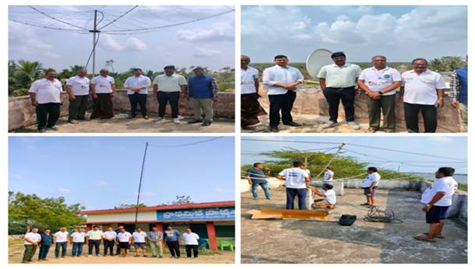
Advocating
last mile connectivity and a HAM in every village, alongside the readiness of
HAMs to aid in communication failures, a dedicated team of amateur radio
operators (HAMs) embarked on a significant journey from the cyclone shelters of
Nachugunta Island, Andhra Pradesh, to participate in the Island on the Air
(IOTA) expedition. It aimed at
integrating HAM education in primary and secondary schools for widespread
adoption and enhanced disaster response across the country. Despite facing
the challenges of a very difficult and remote location, these enthusiasts
showcased the spirit of innovation and resilience that truly embodies the 'Make
in India' ethos in the communication sector.
The
In-charge of the Wireless Monitoring Station in Vijayawada and the Head of the
International Monitoring Earth Station in Jalna, Maharashtra, accompanied by an
official from the Department of Telecommunications (DoT) headquarters, visited
the remote site. During the visit, they commended the steadfast dedication of
the HAM operators, acknowledging their efforts as a reflection of India's
excellence in communication technology.
At the
site, five Amateur High Frequency stations and one Amateur Satellite station
were set up using most of the self-designed and locally developed communication
equipment, showcasing India's commitment to the "Make in India"
initiative. Operating from the disaster-prone village of Nachugunta Island
(AS-199), located in the West Godavari District within the Vijayawada region of
Andhra Pradesh, these operators utilized the cyclone shelters along the Bay of
Bengal coastline as their base for communication.
In the course of their expedition,
the team of HAMs made approximately 4,000 global contacts with HAMs including
from US, Canada, Germany, Japan, South Africa, Europe, Soth Asia etc,
showcasing their proficiency in establishing communication links across the
globe.
Moreover, they seized the opportunity to raise awareness about emergency
communication preparedness, conducting sessions in local schools and villages
to educate the community about the significance of effective communication
during crises.
The
success of this expedition not only highlights the technical expertise of the
HAM operators but also underscores the importance of community engagement and
preparedness in the face of natural disasters. Through their commendable
efforts, the team has not only demonstrated India's capabilities in the field
of amateur radio operations but has also contributed significantly to enhancing
emergency communication resilience in vulnerable areas.
Amateur
radio is a popular hobby involving the use of radio frequency spectrum for
non-commercial purposes. HAM radio operators communicate using designated radio
frequencies, engaging in diverse activities like contests, emergency
communication support, experimentation, technical learning, and community
engagement.
The
hobby offers a unique blend of technical learning, community engagement, and
global connectivity through radio waves, emphasizing innovation and service.